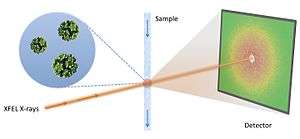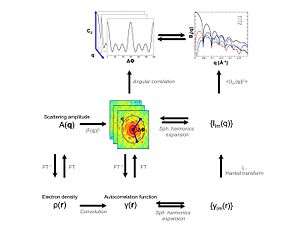Fluctuation X-ray scattering
Fluctuation X-ray scattering (FXS)[1][2] is an X-ray scattering technique similar to small-angle X-ray scattering (SAXS), but is performed using X-ray exposures below sample rotational diffusion times. This technique, ideally performed with an ultra-bright X-ray light source, such as a free electron laser, results in data containing significantly more information as compared to traditional scattering methods.[3]

FXS can be used for the determination of (large) macromolecular structures,[4] but has also found applications in the characterization of metallic nanostructures,[5] magnetic domains[6] and colloids.[7]
The most general setup of FXS is a situation in which fast diffraction snapshots of models are taken which over a long time period undergo a full 3D rotation. A particularly interesting subclass of FXS is the 2D case where the sample can be viewed as a 2-dimensional system with particles exhibiting random in-plane rotations. In this case, an analytical solution exists relation the FXS data to the structure.[8] In absence of symmetry constraints, no analytical data-to-structure relation for the 3D case is available, although various iterative procedures have been developed.
Overview
An FXS experiment consists of collecting a large number of X-ray snapshots of samples in a different random configuration. By computing angular intensity correlations for each image and averaging these over all snapshots, the average 2-point correlation function can be subjected to a finite Legendre transform, resulting in a collection of so-called Bl(q,q') curves, where l is the Legendre polynomial order and q / q' the momentum transfer or inverse resolution of the data.
Mathematical background

Given a particle with density distribution , the associated three-dimensional complex structure factor is obtained via a Fourier transform
The intensity function corresponding to the complex structure factor is equal to
where denotes complex conjugation. Expressing as a spherical harmonics series, one obtains
The average angular intensity correlation as obtained from many diffraction images is then
It can be shown that
where
with equal to the X-ray wavelength used, and
is a Legendre Polynome. The set of curves can be obtained via a finite Legendre transform from the observed autocorrelation and are thus directly related to the structure via the above expressions.
Additional relations can be obtained by obtaining the real space autocorrelation of the density:
A subsequent expansion of in a spherical harmonics series, results in radial expansion coefficients that are related to the intensity function via a Hankel transform
A concise overview of these relations has been published elsewhere[1][3]
Basic relations
A generalized Guinier law describing the low resolution behavior of the data can be derived from the above expressions:
Values of and can be obtained from a least squares analyses of the low resolution data.[3]
The falloff of the data at higher resolution is governed by Porod laws. It can be shown[3] that the Porod laws derived for SAXS/WAXS data hold here as well, ultimately resulting in:
for particles with well-defined interfaces.
Structure determination from FXS data
Currently, there are three routes to determine molecular structure from its corresponding FXS data.
Algebraic phasing
By assuming a specific symmetric configuration of the final model, relations between expansion coefficients describing the scattering pattern of the underlying species can be exploited to determine a diffraction pattern consistent with the measure correlation data. This approach has been shown to be feasible for icosahedral[9] and helical models.[10]
Reverse Monte Carlo
By representing the to-be-determined structure as an assembly of independent scattering voxels, structure determination from FXS data is transformed into a global optimisation problem and can be solved using simulated annealing.[3]
Multi-tiered iterative phasing
The multi-tiered iterative phasing algorithm (M-TIP) overcomes convergence issues associated with the reverse Monte Carlo procedure and eliminates the need to use or derive specific symmetry constraints as needed by the Algebraic method. The M-TIP algorithm utilizes non-trivial projections that modifies a set of trial structure factors such that corresponding match observed values. The real-space image , as obtained by a Fourier Transform of is subsequently modified to enforce symmetry, positivity and compactness. The M-TIP procedure can start from a random point and has good convergence properties.[11]
References
- Kam, Zvi (1977). "Determination of Macromolecular Structure in Solution by Spatial Correlation of Scattering Fluctuations". Macromolecules. 10 (5): 927–934. Bibcode:1977MaMol..10..927K. doi:10.1021/ma60059a009.
- Kam, Z.; M. H. Koch, and J. Bordas (1981). "Fluctuation x-ray scattering from biological particles in frozen solution by using synchrotron radiation". Proceedings of the National Academy of Sciences of the United States of America. 78 (6): 3559–3562. Bibcode:1981PNAS...78.3559K. doi:10.1073/pnas.78.6.3559. PMC 319609. PMID 6943555.
- Malmerberg, Erik; Cheryl A. Kerfeld and Petrus H. Zwart (2015). "Operational properties of fluctuation X-ray scattering data". IUCrJ. 2 (3): 309–316. doi:10.1107/S2052252515002535. PMC 4420540. PMID 25995839.
- Liu, Haiguang; Poon, Billy K.; Saldin, Dilano K.; Spence, John C. H.; Zwart, Peter H. (2013). "Three-dimensional single-particle imaging using angular correlations from X-ray laser data". Acta Crystallographica Section A. 69 (4): 365–373. doi:10.1107/S0108767313006016. ISSN 0108-7673.
- Chen, Gang; Modestino, Miguel A.; Poon, Billy K.; Schirotzek, André; Marchesini, Stefano; Segalman, Rachel A.; Hexemer, Alexander; Zwart, Peter H. (2012). "Structure determination of Pt-coated Au dumbbellsviafluctuation X-ray scattering". Journal of Synchrotron Radiation. 19 (5): 695–700. doi:10.1107/S0909049512023801. ISSN 0909-0495.
- Su, Run; Seu, Keoki A.; Parks, Daniel; Kan, Jimmy J.; Fullerton, Eric E.; Roy, Sujoy; Kevan, Stephen D. (2011). "Emergent Rotational Symmetries in Disordered Magnetic Domain Patterns". Physical Review Letters. 107 (25): 257204. Bibcode:2011PhRvL.107y7204S. doi:10.1103/PhysRevLett.107.257204. ISSN 0031-9007. PMID 22243108.
- Wochner, Peter; Gutt, Christian; Autenrieth, Tina; Demmer, Thomas; Bugaev, Volodymyr; Ortiz, Alejandro Díaz; Duri, Agnès; Zontone, Federico; Grübel, Gerhard; Dosch, Helmut (2009). "X-ray cross correlation analysis uncovers hidden local symmetries in disordered matter". Proceedings of the National Academy of Sciences. 106 (28): 11511–11514. Bibcode:2009PNAS..10611511W. doi:10.1073/pnas.0905337106. ISSN 0027-8424. PMC 2703671. PMID 20716512.
- Kurta, R. P.; Altarelli, M.; Weckert, E.; Vartanyants, I. A. (2012). "X-ray cross-correlation analysis applied to disordered two-dimensional systems". Physical Review B. 85 (18). arXiv:1202.6253. Bibcode:2012PhRvB..85r4204K. doi:10.1103/PhysRevB.85.184204. ISSN 1098-0121.
- Saldin, D. K.; H.-C. Poon, P. Schwander, M. Uddin, and M. Schmidt (2011). "Reconstructing an icosahedral virus from single-particle diffraction experiments". Optics Express. 19 (18): 17318–17335. arXiv:1107.5212. Bibcode:2011OExpr..1917318S. doi:10.1364/OE.19.017318.CS1 maint: multiple names: authors list (link)
- Poon, H.-C.; P. Schwander, M. Uddin, & D. K. Saldin (2011). "Fiber Diffraction without Fibers" (PDF). Physical Review Letters. 19 (18): 17318–17335. Bibcode:2013PhRvL.110z5505P. doi:10.1103/PhysRevLett.110.265505.CS1 maint: multiple names: authors list (link)
- Donatelli, Jeffrey J.; Peter H. Zwart, and James A. Sethian (2015). "Iterative phasing for fluctuation X-ray scattering" (PDF). Proceedings of the National Academy of Sciences of the United States of America. 112 (33): 10286–10291. Bibcode:2015PNAS..11210286D. doi:10.1073/pnas.1513738112. PMC 4547282. PMID 26240348. early edition online ahead of publication